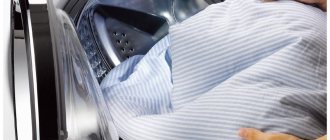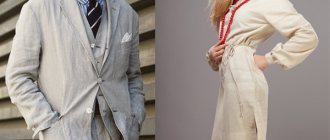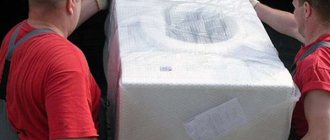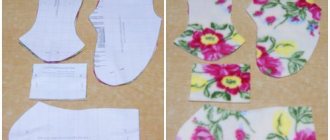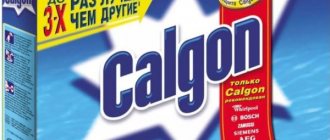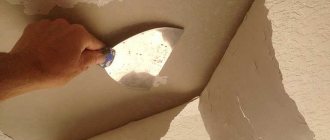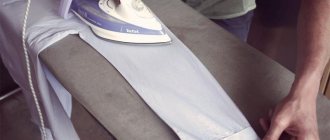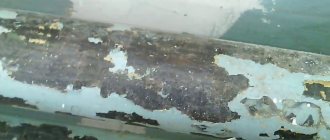A new accessory for the washing machine - a cover that protects the equipment from the accumulation of dust and dirt
Many people still have not heard about the washing machine cover as an ultra-fashionable, stylish and very attractive product. It is multifunctional, despite the fact that it looks simple and elegant. Among experts in the field of researching household appliances and components, there is a lot of controversy regarding the importance of using such a device, but one thing can be noted for sure - it allows you to create a cozy environment, maintain the comfort of the bathroom, and protect the washing machine from accumulations of dust and dirt. Whether to buy a cover or not is a personal matter for everyone, just like whether to sew it yourself or purchase a ready-made model.
Stages of sewing a cover for a washing machine with your own hands
Machine covers are a kind of casing that is used for two purposes - aesthetic and practical. Modern washing machines are similar in structure, size and functionality, and they are especially similar in color and design. How to make your bathroom more stylish, modern and original?
By measuring the dimensions of the washing machine, you can sew a cover yourself
It is worth choosing not only the decoration of the room, but also elements such as a cover for the washing machine.
The creative design of this product will significantly transform household appliances, and all this without high costs. If you purchase covers of various types or sew them yourself, then you can transform the room almost every week at your discretion, and this without harming the equipment in which the clothes are washed.
As for the practical function of these products, it is very extensive:
- By putting on the cover, you can eliminate weekly cleaning in the form of cleaning the case from dust, stains, fingerprints and similar dirt.
- It is possible to prevent fine dirt and small foreign objects from penetrating into the housing. This often causes electronics to malfunction, which costs a lot in restoration and maintenance.
- In order for the washing machine to look as attractive as possible and have a marketable appearance, there should be no chips, scratches or similar damage on it, which, again, can exclude a cover for the washing machine.
- If the device is installed in the hallway or in the kitchen, then it is possible that water, moisture, as well as cleaning agents and detergents will get on the surface of the product. This leads to serious problems with the functioning and also causes incredible problems when cleaning and cleaning the structure. It is much easier to wash the cover, which does not require too much effort, time and money.
The cover is a great way to fit your washing machine into any interior. For example, if the bathroom is made in a classic style, then a marble-effect cover is perfect, and if a design solution in the style of the Victorian era is used in the bath, then you can choose a cover with an ornament in the form of many flowers, and of a small size.
Correct Application
Using a cover is not only aesthetically pleasing and practical, but also dangerous. If used incorrectly, the housing may accumulate moisture, which will lead to rust and corrosion of the housing. Therefore, during washing, it is advisable to completely remove it, or open the curtains for normal ventilation.
Having weighed the pros and cons of the invention, you can start making it. A fabric casing is convenient and beautiful when used to enhance the aesthetics of a room. But it should not interfere with the washing machine performing its function.
Selection of covers for washing machines
It is quite possible to sew a product such as a cape with your own hands, you just need to pay attention to a number of points. There are different types of washing machines - side-loading and top-loading, narrow and wide, high and low. Depending on the model of the product, you should select the type of cover so that it fits exactly according to the parameters and does not hang over the edges or, conversely, does not crack when put on.
A wide variety of covers allows you to use them on different models of washing machines
Basically, the covers are divided into top-loading and side-loading washing machines.
The peculiarity of the cover for the first model of washing machines is that the product consists of 2 parts, one of which is designed to cover the main part of the machine, and the second directly for the upper part through which the laundry is loaded.
The part that folds back can be on:
- Lock;
- Buttons;
- Buttons.
Front-loading washing machines are in great demand, just like covers for them. They are very easy to use and don't require too much effort. To open the hatch, just disconnect the folding part and use the device for its intended purpose. This part can also be secured with Velcro, a lock, or buttons.
If you buy not just a case, but a product that is equipped with a lot of additional accessories, then it will bring maximum pleasure from use. These include pockets for conditioner, powder and other small items important for this process.
Preparation of the upper part of the cape
The upper part of the cape will consist of three equal parts, the seams of which will be decorated with lace and ribbon.
From white linen you should cut out 3 pieces measuring 22*42 cm.
Then the 2 parts need to be folded inside out to each other and stitched at a distance of 1 cm from the longitudinal sections.
The third part must be sewn in the same way.
The seam allowances of the central part must be cut to 5 mm.
The allowances of the side parts should go around the allowances of the central part. The resulting closed seam must be ironed.
You need to sew lace with holes over the seams.
For additional decoration of the lace, a satin ribbon will be used. It should be inserted into a needle with a large eye. To prevent the ribbon from slipping out during sewing, its tail should be glued with a small amount of glue not far from the eye of the needle.
Using a needle, insert the ribbon into the holes of the lace. The tails of the ribbon need to be melted and sewn at the beginning and end of the lines using several hand stitches.
How to sew a cover for a washing machine step by step
It is quite possible to sew a cover step by step with any size, even 40x60, even with larger parameters. A cover for a washing machine is an original, stylish, and very attractive product. Its peculiarity is that you can purchase it, or you can make it with your own hands, which will save money and allow you to create it in a way that fully satisfies your personal preferences.
The fabric used to sew the washing machine cover must have water-repellent properties.
To make it you need to prepare:
- Fabric with water-repellent effect;
- Tailor's meter;
- Ruler;
- Scissors;
- Threads;
- A needle;
- Maces.
It is much easier to sew such a product on a sewing machine, which will reduce production time. Initially, a pattern is made, which requires measurements of the product. The parameters are transferred to the surface of the fabric from the inside.
Basically, for a front-loading washing machine, dimensions of 85x66x44 cm are sufficient, and for a vertical one – 90x40x65 cm.
It is imperative to consider a folding curtain on the side on which the loading hatch is located. You can separately make a small folding curtain for the control panel, or cover this window with transparent fabric, which will allow you to set the desired mode without removing the cover.
Preparing the frill of the cape
The frill of the cape will be stitched, consisting of white and ivory parts. In addition, it will be made on a thin lining (so that the folds hold their shape better).
From flax of two colors you should cut out the details of the future frill of the cape.
- 4 parts 28*35 cm (for corners);
- 12 pieces 15*35 cm (for the outer part of the folds).
Ivory linen:
- 16 pieces 8*35 cm (for the inside of the folds).
Then they need to be sequentially sewn together in the following order:
- corner;
- inner fold;
- outer fold;
- inner fold;
- outer fold;
- inner fold;
- corner (you get a frill on one of the short sides);
- inner fold;
- outer fold;
- inner fold;
- outer fold;
- inner fold;
- outer fold;
- inner fold;
- outer fold;
- inner fold;
- corner (you get a frill on one of the longitudinal sides).
Similarly, you need to assemble the second short and second long sides of the frill. There is no need to sew the frill into the ring yet.
The seam allowances for sewing parts of the frill should be pressed towards the inner parts of the folds.
The result should be a frill blank 3.82 m long.
From the voile it is necessary to cut out a lining for the frill 2.82 m long and 34.5 cm wide.
The lining must be placed on the frill (face to face), aligned along the lower edges and stitched with a seam 7 mm wide.
The facing seam allowance must be pressed onto the lining.
After this, the frill blank and the lining should be stitched into a ring. The seam allowance should be pressed towards the inside of the ivory linen fold.
Then the lining and frill need to be folded with the wrong sides facing each other, aligned along the upper edges and secured with an auxiliary stitch 3 mm from the edges.
The frill needs to be ironed over the entire area.
Lace should be stitched along the bottom of the frill.
It, similar to the lace on the top of the cape, needs to be supplemented with a satin ribbon.
Then the frill should be gathered into folds. For this purpose, its upper cut needs to be marked with pins.
For each part of the frill (corner, outer part of the fold, inner part of the fold) you need to mark the middle.
The width of each outer part of the fold should be 10 cm. That is, 5 cm should be set aside from the middle in both directions.
The width of the corners should be 20 cm. It is necessary to set aside 10 cm from the middle to the right and left.
The width marks of the corners and outer parts of the folds should be aligned with the middles of the inner parts. The result should be shallow bow folds.
Making a cover for a washing machine 40x60
The idea of using a cover for a washing machine is original, practical, and stylish. Naturally, sewing a case with your own hands is a very exciting process that allows you to bring your own design to life, however, it is possible to purchase a finished product that will have everything you need, including additional pockets.
Having a special cover, the washing machine will fit into any interior without much difficulty
The most important thing is that the cover is made of a material that does not accumulate dust, repels moisture and water, and is easy to wash, dry, and iron.
As a rule, covers sold in stores are made of durable polyethylene and covered with cotton fabric. There can be an unlimited number of decor options, as they are produced in a large assortment.
There are differences in:
- Design;
- Blossom;
- Cost;
- Sizes.
Where can I buy?
For residents of large cities, finding a case in a large hardware store will not be difficult, but everyone else will have to run around looking for this, not yet quite familiar, accessory. However, there is another possible solution: order a case from an online store: the choice of cases online is very diverse, so you can easily find a suitable option. Many stores provide free delivery not only within Russia, but also from abroad, so making purchases remotely is often just as profitable as in a regular store. When placing an order, be sure to pay attention to the dimensions of the cover: there are universal models that can be adjusted in length and width.
LiveInternetLiveInternet
—Categories
- dolls (1168)
- toys (493)
- mk (445)
- Author's toys (358)
- pattern diagrams (265)
- tildes (209)
- clothes (179)
- shoes (110)
- sew (733)
- modeling (172)
- sewing tricks (97)
- for the new year (650)
- decorations (499)
- cooking (445)
- bread (29)
- outfits (391)
- evening dresses (87)
- children's dresses (33)
- we sew for children (340)
- beads (337)
- fabric flowers (331)
- health (300)
- games with children (297)
- for development and training (69)
- elastic bands bows headbands (271)
- knitting (267)
- dessert (241)
- design (237)
- alterations (221)
- MK (209)
- for the garden (197)
- for home (183)
- hairstyles (179)
- interesting (173)
- paper crafts (160)
- assistance to the hostess (149)
- makeup manicure (118)
- decoupage (109)
- winter preparations (108)
- plastic (97)
- interior (95)
- bags (75)
- beauty (64)
- VALENTINE'S DAY (51)
- embroidery (50)
- for computer (43)
- from plastic bottles (42)
- furniture (37)
- paska (32)
- wedding (10)
- for diary (9)
- (1)
-I'm a photographer
Purpose
Products that fit onto washing machines are designed to perform the following functions:
Most often, modern household appliances are offered to customers in black, metal and white, as well as in their combinations. With the help of accessories for the “washing machine” you will be able to diversify the usual appearance of the product and successfully fit it into the interior of the room.
For example, a marble-colored mantle will look good in a classic interior, while a floral design will look good in a Victorian-style room.
With the help of such textile products it will be possible to create a cozy atmosphere in the room and complete the previously created design. Moreover, it is worth knowing that there are absolutely no restrictions on the materials used to make car covers, as well as on their design.
With the help of a cover for a washing machine, you can achieve the following goals:
Advantages and disadvantages
Like any thing, washing machine covers have their advantages and disadvantages, which are worth noting separately.
The advantages of using covers include:
- protection of the device from mechanical damage;
- protection from children;
- protection against water ingress;
- giving a decorative look to the room.
Disadvantages include:
- deterioration of air circulation, which impedes the outflow of heat;
- the likelihood of mold and rust.
